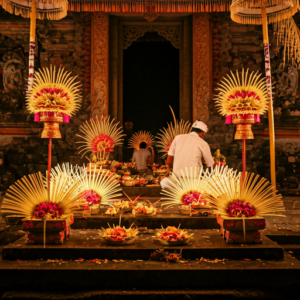Nestled in the lush landscapes of central Bali, the Tirta Empul Water Temple stands as a testament to the island’s rich spiritual heritage and intricate connection between nature, culture, and religious practice. This ancient temple, located near the town of Ubud, is more than just a historical site—it is a living, breathing sanctuary that continues to play a crucial role in Balinese Hindu spiritual life.
A Glimpse into Historical Origins
The origins of Tirta Empul date back to the 10th century, during the Warmadewa dynasty of the Balinese kingdom. Archaeological evidence suggests that the temple was constructed around 962 CE, making it over a thousand years old. The name „Tirta Empul“ itself is deeply meaningful, translating to „holy spring“ in Balinese, which precisely describes the temple’s most distinctive feature—its sacred water sources.
According to local legends, the temple’s creation is intertwined with a fascinating mythological narrative. The story speaks of a powerful but tyrannical king named Mayadenawa, who was known for his opposition to the Hindu gods. In response to his actions, the god Indra created a magical spring, which became the foundation of the Tirta Empul temple. This mythical origin underscores the temple’s significance as a place of divine intervention and spiritual power.
The Architectural Marvel of Sacred Waters
The temple complex is a remarkable example of traditional Balinese architecture, featuring intricate stone carvings, beautifully designed pavilions, and a series of holy water pools. These pools are fed by natural springs that emerge from the ground, believed to have extraordinary purification properties.
The main attraction of Tirta Empul is its series of water spouts, each with its own spiritual significance. Devotees and visitors participate in a ritualistic bathing ceremony, moving systematically through multiple water channels. Each spout represents a different blessing or purification purpose, ranging from physical cleansing to spiritual renewal.
The Purification Ritual
The purification ritual, known as „melukat,“ is a profound spiritual experience. Participants enter the pools wearing traditional Balinese attire, typically a sarong and sash. They move from one water spout to another, offering prayers and submerging themselves completely under each stream. The water is considered holy, capable of washing away negative energies, sins, and spiritual impurities.
Interestingly, the ritual follows a specific sequence. Participants start from the easternmost spout and progress westward, symbolizing a journey from darkness to light, from impurity to spiritual clarity. The water is remarkably cool and crystal clear, emerging from underground springs that have been revered for centuries.
Cultural Significance and Modern Relevance
While Tirta Empul remains a critical religious site for Balinese Hindus, it has also become an important cultural landmark that attracts visitors from around the world. The temple offers a unique window into the spiritual practices of Bali, demonstrating how ancient traditions continue to thrive in the modern world.
During important Hindu ceremonies like Galungan and Kuningan, the temple comes alive with vibrant rituals. Hundreds of devotees gather, dressed in traditional white and colorful ceremonial attire, creating a breathtaking spectacle of cultural preservation and spiritual devotion.
Environmental and Spiritual Harmony
The temple complex is not just a spiritual center but also an excellent example of environmental consciousness. The water management system at Tirta Empul showcases the sophisticated understanding of natural resources by Balinese culture. The springs are carefully maintained, and the water flow is managed in a way that respects both human needs and ecological balance.
Practical Visitor Information
For those planning to visit Tirta Empul, there are several important considerations:
- Modest dress is mandatory. Visitors must wear a sarong and sash, which can be rented at the temple entrance.
- While tourists are welcome to observe and participate in the bathing ritual, it’s crucial to approach the experience with respect and understanding.
- The best times to visit are early morning or late afternoon when the light is softer and the crowds are smaller.
- Guided tours are available and highly recommended to gain deeper insights into the temple’s history and spiritual significance.
Preserving a Living Tradition
Tirta Empul represents more than just a historical site—it’s a living, breathing testament to Balinese spiritual resilience. Despite centuries of cultural changes and external influences, the temple continues to serve its original purpose, connecting people with their spiritual roots.
Local communities play a crucial role in maintaining the temple’s integrity. Young Balinese people are actively involved in preserving the rituals, ensuring that the knowledge and spiritual practices are passed down through generations.
Philosophical Underpinnings
The philosophy behind Tirta Empul goes beyond physical purification. It represents a holistic approach to spiritual wellness, emphasizing the interconnectedness of body, mind, and spirit. The ritual of water purification is seen as a metaphor for internal cleansing, where external actions reflect and facilitate internal transformation.
Conclusion: A Sanctuary of Spiritual Renewal
Tirta Empul Water Temple stands as a powerful symbol of Bali’s spiritual depth. It reminds us that spirituality is not a static concept locked in ancient texts, but a living, breathing practice that continues to evolve and inspire.
For visitors, the temple offers a rare opportunity to witness and potentially participate in a deeply meaningful spiritual tradition. It invites us to pause, reflect, and connect with something greater than ourselves—a universal human desire that transcends cultural boundaries.
Whether you’re a spiritual seeker, a cultural enthusiast, or simply a curious traveler, Tirta Empul promises an experience that will linger in your memory long after you’ve left its sacred grounds.






